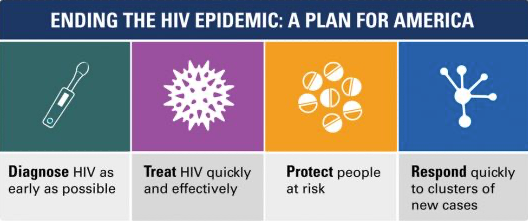Ending the HIV Epidemic: A Plan for America - An Ambitious Pathway to Eradicate HIV by 2030
- thomasschucker
- Aug 24, 2023
- 3 min read

Since the early 1980s, HIV/AIDS has claimed the lives of more than 700,000 people in the United States alone, with millions more affected globally. While the emergence of antiretroviral therapies has changed HIV from a death sentence to a manageable chronic illness for many, it remains a serious public health crisis.
Fortunately, we are now at a unique juncture with the potential to radically change the trajectory of the HIV epidemic. “Ending the HIV Epidemic: A Plan for America” is the U.S. government’s ambitious plan aimed at reducing new HIV infections in the United States by at least 90% by 2030. This blog post explores the goals, strategies, and opportunities presented by this historic plan, along with a call to action for individuals to engage their communities to help achieve this monumental objective.
The Four Pillars of the Plan

1. Diagnose
The first pillar of the plan emphasizes early and accurate diagnosis for all individuals who are infected with HIV. Despite significant advancements in testing methods, an estimated 14% of people with HIV in the U.S. don't know they are infected. Early diagnosis can lead to early intervention, which is critical for individual health outcomes and preventing transmission to others.
2. Treat
Immediate linkage to treatment following an HIV diagnosis is the cornerstone of the second pillar. Antiretroviral therapies (ART) have revolutionized HIV care. Achieving and maintaining viral suppression not only significantly improves the health of the individual but also makes it virtually impossible for them to transmit HIV to others.
3. Prevent
Prevention is not just about awareness; it's about action. This pillar aims to provide high-risk populations with preventive interventions, including pre-exposure prophylaxis (PrEP), a medication that can significantly reduce the risk of HIV acquisition.
4. Respond
Despite best efforts, outbreaks will occur. This pillar focuses on rapidly identifying and responding to emerging clusters of HIV infection to prevent new outbreaks. This involves a multi-sectoral approach, including healthcare providers, state health departments, and community-based organizations.
Funding and Implementation
The plan comes with significant federal funding targeted toward enhancing existing programs and establishing new ones. However, effective implementation will require a collective effort from federal, state, and local governments, non-profit organizations, healthcare providers, and community stakeholders.
Barriers and Challenges
While the plan is ambitious, several barriers must be addressed:
Stigma: Stigma associated with HIV and marginalized communities continues to be a major obstacle.
Access to Healthcare: Many of those most at risk of HIV infection have limited access to healthcare services.
Education and Awareness: There's a dire need to educate communities, particularly young people, about HIV.

A Call to Action: How You Can Help
Ending the HIV epidemic is a monumental task that cannot be achieved by policy alone. Here’s how you can contribute:
Educate
Talk openly about HIV prevention, treatment, and living with HIV. Host or attend community educational forums and use social media to spread awareness.
Advocate
Contact your local and national representatives to prioritize HIV prevention and treatment measures. Advocate for comprehensive sexual education, access to healthcare, and other essential social services.
Volunteer
Contribute your time or skills to organizations that are working towards ending the HIV epidemic. This can include community outreach, providing expert knowledge, or helping with fundraising.
Donate
Financial contributions can go a long way in supporting research initiatives, community programs, and advocacy efforts.
“Ending the HIV Epidemic: A Plan for America” is an ambitious but achievable initiative that aims to significantly reduce new HIV infections by 2030. While the government plays a critical role, success ultimately lies in the hands of individuals and communities who can help break down the barriers that have hindered progress for decades. Together, we can turn the tide and make HIV a thing of the past.
Let's not just hope for a future without HIV—let's act to create it.
---
References:
1. [Ending the HIV Epidemic: A Plan for America](https://www.hiv.gov/federal-response/ending-the-hiv-epidemic/overview)
2. [CDC: HIV in the United States by Region](https://www.cdc.gov/hiv/statistics/overview/ataglance.html)
3. [UNAIDS: Global HIV & AIDS statistics — 2021 fact sheet](https://www.unaids.org/en/resources/fact-sheet)
---
For more information on how to get involved, visit https://www.hiv.gov
Comments